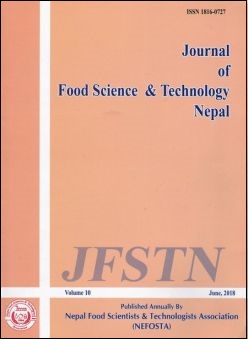Encapsulation of Saccharomyces cerevisiae in alginate beads and its application for wine making
DOI:
https://doi.org/10.3126/jfstn.v10i0.19631Abstract
A study was carried out on encapsulation of wine yeast (Saccharomyces cerevisiae) and its use in wine making compared to free yeast. Rehydrated active dry yeast was encapsulated in a 2% sodium alginate solution, cross linked with different molar concentration of CaCl2 solution (0.1, 0.2, 0.3,0.4 and 0.5M) for 30 minutes. The molar concentration with minimum cell leakage (0.2M) was used for yeast encapsulation. Colony count (CFU/ml) was analyzed for both free yeast (FY) and encapsulated yeast (EY) so as to equilibrate the rate of yeast pitching in wine fermentation. Physico-chemical properties; total soluble solids (T.S.S.), acidity and pH of red and white grapes were analyzed and were found to be 16.4±0.10oBx, 0.38±0.02% and 3.90±0.02 for white grapes and 19±0.15oBx, 0.64±0.01% and 3.1±0.10 for red grapes. During the fermentation process in both wines, a gradual reduction in T.S.S. was noted while an alternate of increase and decrease trend in acidity was noted which finally stabilized after 12 days. The final T.S.S. of wines was not significantly different for yeast types but higher values were noted for red wine (FY, 7.11±0.26 & EY, 7.33±0.19) than for white wine (FY, 6.1±0.10 & EY, 6.2±0.10). Similar trend was noted for final acidity of red wine (FY, 0.83±0.01 & EY, 0.84±0.02%). Though, no significant effect of yeast type on alcohol production was noted, the average alcohol content of red (FY, 13.22±0.26% & EY, 13.72±0.44%) and white (FY, 9.21±0.21% & EY, 9.64±0.38%) wine were found to be significantly different. However, wine prepared from EY was less turbid (Red wine, 95 NTU & White wine, 140 NTU) and had higher clarity (L*) than wine from FY. So, from this study it was concluded that encapsulating wine yeast does not affect its fermenting capability but will aid in production of less turbid wine which will definitely simplify the filtration process.
Downloads
Downloads
Published
How to Cite
Issue
Section
License
The author will be the copyright holder of this open access journal - 'Journal of Food Science and Technology Nepal (JFSTN)'.




